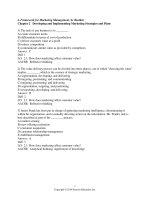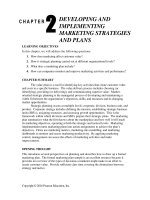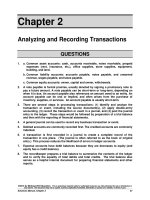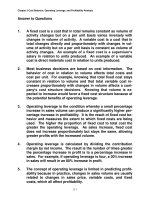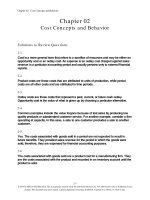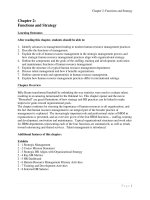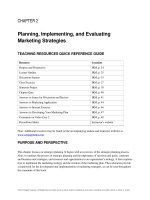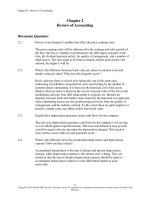Test bank and solution manual for accounting for accruals (1)
Bạn đang xem bản rút gọn của tài liệu. Xem và tải ngay bản đầy đủ của tài liệu tại đây (778.92 KB, 35 trang )
Chapter 2
Accounting for Accruals and Deferrals
General Comments for Chapter 2
This chapter introduces accrual accounting. A key concept in this chapter is for the student to understand that revenues
earned must be matched with expenses incurred to earn those revenues, regardless of when the cash exchange occurs.
You can introduce the subject simply by using a single accounting event in which a business provides services on account. Chapter 1 assumed that all transactions were cash-based, but we all know that reality in the business world includes products and services purchased and sold ‘on credit’ or ‘on account’. Show students the effect of this accrual by
having them prepare an income statement, a statement of retained earnings, a balance sheet, and a statement of cash
flows. Students will often stumble on the concept of Unearned Revenue, thinking that it’s actually a revenue account
when in fact it’s a liability. Explain how customer payments that are received before goods or services are provided
must be refunded to the customer if those promised goods or services are never actually delivered. Similarly, show students the effect of interest on the financial statements without mixing interest computations into the example. Students
frequently get so lost in the computations they overlook the financial statement impact of interest. Initially provide students with the amount of interest, freeing them to focus on its effects. Once students understand how accrued interest
affects the financial statements, then cover the mechanics of interest computations. Encourage students to record transactions using the horizontal financial statements model, even when problems do not require them to do so. Developing
the habit of recording transactions using the model will help students see the impact of each transaction on the financial
statements as well as help students identify their errors if the accounting equation is not in balance. Specific examples
are provided in the detailed lesson plan outline. If you would like to begin the chapter with a problem-based learning
exercise, see the notes below.
2-1
Copyright © McGraw-Hill Education. Permission required for reproduction or display.
Problem-Based Learning Case: Accrual Accounting
(We describe problem-based learning in the introduction to this manual.)
Instructions: The case appears on the following page in a format you can copy or display. Distribute copies of the case
to the class before explaining accrual accounting. Ask students to individually develop answers. After allowing students
time to develop their individual answers, put them into groups to reach consensus on an answer. Also, ask each group to
select a spokesperson. Allow groups time to develop answers, and then call on some of the spokespersons to share their
solutions. As you respond to the student solutions, explain the basic concepts of accrual accounting with respect to revenues earned and expenses incurred on account.
The final result is:
Net income: revenue of $145,000 less expenses of $80,000 = $65,000.
Total assets: cash, $45,000 plus accounts receivable, $25,000 = $70,000.
Total liabilities: salaries payable: $5,000.
2-2
Copyright © McGraw-Hill Education. Permission required for reproduction or display.
Chapter 2 Problem-Based Learning Case: Accrual Accounting
Professional Headhunters, Inc. (PHI), a job placement company, operates in the northeastern United States. During 2015 the company earned $145,000 in revenue by providing services to customers. However, it collected only $120,000 of the revenue in cash.
PHI expected to collect the remaining $25,000 in 2016. In addition, PHI incurred $80,000
of expenses. However, by the end of 2015, PHI had paid only $75,000 of the cash owed
for expenses because it had not yet paid $5,000 to employees who had worked during
2015 but not been paid by the end of the year. PHI expected to pay the $5,000 in cash
to the employees during 2016. Based on this information alone, determine the amount
of net income, total assets, and total liabilities PHI should report on its 2015 financial
statements.
2-3
Copyright © McGraw-Hill Education. Permission required for reproduction or display.
Detailed Outline of a Lesson Plan for Chapter 2
I. Distribute copies of Demonstration Problem 2-1, found near the back of this chapter of the Instructor’s Manual.
A. Explain the phrase “on account.” Tell students this means Packard recognizes the revenue when it is earned,
which may be before it collects the cash. Packard’s customers created charge accounts and purchased goods
or services by charging the purchases to their accounts. Revenue is recognized in the accounting period in
which the services are provided regardless of when cash changes hands. This discussion should lead to defining the term accrual. In general, transactions in which a revenue or expense is recognized before cash changes hands are called accruals. Demonstrate this point by recording the revenue recognition for Packard using
the horizontal financial statements model. Next, have your students prepare an income statement, a statement
of retained earnings, a balance sheet, and a statement of cash flows. To minimize the time required to prepare
these financial statements, you may provide students with copies of the workpaper for Demonstration Problem 2-1. The workpaper is near the back of this chapter of the Instructor’s Manual.
B. Since Packard did not issue any stock, the statement of changes in stockholders’ equity becomes a statement
of retained earnings. Although the text does not cover a statement of retained earnings, students should be
able to infer the format from their experience with the statement of changes in stockholders’ equity. Use the
exercise to discuss diversity in reporting practice. Although there is general consistency in financial reporting, there is also variety. Students should learn to understand different reporting formats.
C. After accounting for the 2015 revenue, assume Packard collects the $5,000 account receivable in 2016. This
is the only 2016 transaction. Have students record the event using the horizontal financial statements model
and prepare the four basic financial statements for the 2016 accounting period. Encourage students to analyze
the difference between the amount of net income and the amount of cash flow from operating activities. This
single transaction clearly illustrates differences between the income statement and the statement of cash
flows.
2-4
Copyright © McGraw-Hill Education. Permission required for reproduction or display.
D. Introduce the term unearned revenue before starting part B of this problem. Explain that unearned revenue
is a liability because it represents an obligation to provide future services. Make the point that businesses
can be obligated to provide services as well as to pay cash. Show your students how to record the liability using the horizontal financial statements model.
E. Explain the year-end adjustment necessary to recognize three months of earned revenue on December 31.
Emphasize the difference between the amount of cash collected and the amount of revenue recognized. Highlight that Jackson earned and recognized the revenue after it collected the cash. Draw a general definition of
deferrals from this illustration. Transactions in which a revenue or expense is recognized after cash changes hands are termed deferrals. Contrast deferrals with accruals which were presented in part A of Demonstration Problem 2-1. For emphasis, reiterate the explanation of an accrual. Transactions in which a revenue
or expense is recognized before cash changes hands are termed accruals. Although these are not precise
definitions, they describe the basic concepts in terms students can understand. Explain that accrual accounting uses both accruals and deferrals.
F. Also note the connection between reducing the liability account (unearned revenue) and recognizing revenue,
reinforcing that revenue is an increase in assets or a decrease in liabilities from providing services or products to customers. Similarly, an expense is a decrease in assets or an increase in liabilities that occurs in
efforts to produce revenue. Net income is a change in wealth (increase in net assets). It is not enough to
orally define terms. You must repeatedly demonstrate the definitions within the context of problems. Gradually, students will understand fundamental accounting interrelationships.
II. Use Demonstration Problem 2-2 to introduce accrued interest. Master copies of the problem, solution, and
workpapers are located near the back of this chapter of the Instructor’s Manual. The following description of the
transactions includes explanatory comments in italics.
A. Events for 2015 are as follows:
1. Canton Company borrowed $10,000 cash from the National Bank on September 1, 2015. The loan was
to be repaid in 2016, along with all interest associated with the loan. The 2015 transactions do not involve common stock, dividends, or other superfluous elements that are not germane to the subject of in2-5
Copyright © McGraw-Hill Education. Permission required for reproduction or display.
terest. Whenever possible, use an isolated set of transactions that focuses on a specific topic. When
multiple topics are introduced simultaneously, students experience information overload, which leads to
memorization. This problem focuses on borrowing money, using the borrowed money to invest in revenue-earning assets, and matching the investment revenue with the interest expense.
2.
Canton invested the all of the borrowed money in securities that generated investment revenue.
3.
Canton earned investment revenue of $600 cash.
4.
As of December 31, 2015, accrued interest (interest expense) on Canton’s bank loan was $400. You will
want students to understand that the accrued interest is the amount of interest expense from the date of
the loan (September 1) through the end of the year. Even though the interest will not be paid until 2016,
there is some portion of the total interest amount that is expense in 2015. Explain that Canton had the
use of the borrowed money from September through December 2015 and that interest represents the expense that Canton must pay for the use of that money. The amount of interest is provided. This example
focuses on how interest expense affects the financial statements. Computing the amount of interest will
be addressed in a subsequent problem. Once again, the objective is to avoid introducing too many topics simultaneously. Use this entry to expand the definition of an expense. The increase in the liability
account is paired with expense recognition. Define expenses as decreases in assets or increases in liabilities that occur in the effort to produce revenue.
Have students record the events using the horizontal financial statements model and prepare financial statements for the accounting period ended December 31, 2015. This might be a good point to ask the students if
Canton made a wise business decision to invest the borrowed money since the interest expense of $400 generated investment revenue of $600. You can point out that the Statement of Cash Flows shows the financial
statement reader that Canton borrowed money to fund the investment and the Income Statement helps the financial statement reader determine whether or not that was a wise decision.
B. After preparing the 2015 statements, assume these 2016 events:
2-6
Copyright © McGraw-Hill Education. Permission required for reproduction or display.
1.
Canton earned investment revenue of $1,350 cash in 2016.
2.
Canton sold its securities for $10,000 cash.
3.
Canton accrued interest of $800 on the bank loan. The accrual of interest and the payment of interest
are shown as separate transactions. While combining transactions reduces recording time in a manual
accounting system, doing so masks the logic behind the steps. Since the objective is to teach students to
understand accounting rather than how to save time recording transactions, avoid complex entries.
4.
Canton paid cash for the interest due on the bank loan. Remind the students that some portion of the interest due was recorded in 2015 and the remainder of the interest due was recorded in 2016.
5.
Canton repaid the $10,000 bank loan with cash.
III.
Use separate examples to introduce other types of deferrals (prepaid assets, supplies, and long-term depreciable assets). You can use exercises 2-3 A or B or 2-9 A or B in the textbook as demonstration problems, or
create your own. We often make up demonstration problems like these in the classroom. Encourage students to
think by asking them to attempt to record the effects of events before you discuss them. For example, instead of
defining prepaid assets, simply give the students an event involving a prepaid asset. Say, “On October 1, 2015,
ABC Company paid $1,200 in advance for one year of property insurance protection.” Without having ever discussed prepaid insurance, ask the students to record the event using the horizontal financial statements model.
Make them write down an answer. Don’t be concerned with accuracy. Be concerned with involvement. Walk
around the room and look at what they are doing. Occasionally collect these exercises from the students as inclass assignments. Give them credit regardless of their answers. The grade is for participation, not accuracy.
Your objective is to motivate them to think about the problem before you offer a solution. At this stage, you are
not evaluating their performance.
IV.
Time considerations and homework assignments. Completing Demonstration Problems 2-1 and 2-2 should require approximately one hour of class time. Have the students work along with you as you explain the problems.
2-7
Copyright © McGraw-Hill Education. Permission required for reproduction or display.
Exercises 2-3, 2-9, 2-13, and 2-16 parallel the Demonstration Problems and can be considered for homework assignments.
V. Use Demonstration Problem 2-3 as a comprehensive summary problem. This is a two-cycle problem. Explain the first cycle (2015) and then use the second cycle as an in-class assignment. Allot approximately one
hour to complete this assignment. Students needing additional time can finish the problem as homework. Problem 2-28A or B mirrors the demonstration problem and can be used as a homework assignment.
VI. Use the horizontal financial statements model to highlight the differences between accrual and cash basis
accounting. For example, suppose a company provides $5,000 of services on account and later collects $3,000
of the account receivable. The effect of these two events on the financial statements is shown below.
Event
No.
1
2
Cash
NA
3,000
Balance Sheet
+ Acct. Rec. = Liab.
+ 5,000
=
NA
+ (3,000) =
NA
+ Equity
+ 5,000
+ NA
Income Statement
Rev. Ä Exp. = Net Inc.
5,000 Ä n/a = 5,000
NA Ä n/a = NA
Statement of
Cash Flows
NA
+3,000 OA
Include other events you deem appropriate. By this point students have a sufficient background to use the horizontal financial statements model. It is critically important to establish a firm foundation in the basics before
progressing to more advanced representations. Introduce the model gradually.
VII. Hand out the official answers to any of the Demonstration Problems that you covered in class. Doing so
allows the students to focus more on understanding the material than on taking notes for later reference. If they
know that they will have access to the official answers to the problems worked in class, then they will not be as
concerned about recording those answers during the discussion.
2-8
Copyright © McGraw-Hill Education. Permission required for reproduction or display.
Demonstration Problem 2-1A - Revenue Earned on Account
Part A
Packard Consultants was started in 2015. During that year the company earned $5,000 of consulting revenue on account. Assume this is the only event experienced by Packard during 2015.
Required
1. Record the event using the horizontal financial statements model.
2. Prepare an income statement, a statement of retained earnings, a balance sheet, and a statement of cash flows for
2015.
Part B
During 2016, Packard Consultants collected $5,000 cash from the account receivable it established in Part A.
Required
1. Record the event under using the horizontal financial statements model.
2. Prepare an income statement, a statement of retained earnings, a balance sheet, and a statement of cash flows for
2016.
Demonstration Problem 2-1B - Unearned Revenue
Jackson Legal Services was started when a client paid the firm a $12,000 cash retainer on October 1, 2015. Jackson
agreed to provide legal advice to the client for a one-year period beginning on the date of the cash receipt. The closing
date for the law practice is December 31.
Required
1. Record the events for 2015 and 2016 using the horizontal financial statements model.
2. Prepare an income statement, a statement of retained earnings, a balance sheet, and a statement of cash flows for
2015 and 2016.
2-9
Copyright © McGraw-Hill Education. Permission required for reproduction or display.
Demonstration Problem 2-2 - Accrued Interest Payable
Part A
Canton Company experienced the following accounting events during 2015:
1.
2.
3.
4.
Canton Company borrowed $10,000 cash from the National Bank on September 1, 2015.
Canton invested the borrowed money in securities.
Canton earned investment revenue of $600 cash.
As of December 31, 2015, accrued interest (interest expense) on Canton’s bank loan was $400. All interest will be
paid to National Bank in 2016.
Required
1. Record the events using the horizontal financial statements model.
2. Prepare an income statement, a statement of retained earnings, a balance sheet, and a statement of cash flows for
2015.
Part B
Canton Company experienced the following accounting events during 2016:
1.
2.
3.
4.
5.
Canton earned investment revenue of $1,350 cash in 2016.
Canton sold its securities for $10,000 cash.
Canton accrued interest of $800 on the bank loan.
Canton paid cash for the interest due on the bank loan.
Canton repaid the $10,000 bank loan with cash.
Required
1. Record the events using the horizontal financial statements model.
2. Prepare an income statement, a statement of retained earnings, a balance sheet, and a statement of cash flows for
2016.
2-10
Copyright © McGraw-Hill Education. Permission required for reproduction or display.
Demonstration Problem 2-3 - Accruals and Deferrals
Part A Smith Company experienced the following accounting events during 2015:
1.
2.
3.
4.
5.
6.
7.
8.
9.
Smith Company was started when it issued common stock for $2,000 cash.
On September 1, 2015, Smith invested $1,000 cash in a certificate of deposit at Savings Bank.
During the year, the company recognized $1,500 of consulting revenue on account.
The company collected $1,200 cash from accounts receivable.
Smith accrued salary expense during the year of $900.
Paid $700 of the salaries payable liability.
Paid dividends of $100 to the stockholders.
Paid $360 cash for an insurance policy that covered the company for one year beginning March 1, 2015.
On November 1, 2015, Smith collected $2,880 cash in advance for consulting services to be provided under a oneyear contract.
10. Smith adjusted the books to recognize $20 of accrued interest on the certificate of deposit.
11. Recognized insurance expense for ten months.
12. Recognized income earned under the one-year contract
Part B Smith Company experienced the following accounting events during 2016:
1.
2.
3.
4.
5.
6.
7.
8.
Smith Company issued additional common stock for $3,000 cash.
During the period Smith recognized $2,700 of consulting revenue earned on account.
Smith collected $2,800 cash from accounts receivable.
Smith accrued salary expense of $1,500.
The company paid $1,350 of the salaries payable liability.
Smith paid dividends of $300 to the stockholders.
Smith borrowed $2,000 cash from the State Bank.
On August 31 Smith accrued the remaining $40 of interest on the certificate of deposit, collected the cash due
from interest receivable, and received the return of principal.
9. Paid $420 cash to renew the insurance policy for another one-year term.
2-11
Copyright © McGraw-Hill Education. Permission required for reproduction or display.
10. On November 1, Smith purchased land for $6,000 cash. The land had a market value of $6,400 as of December
31, 2016.
11. Smith adjusted the books to recognize accrued interest of $75 on the note payable (see Event No.7) to the State
Bank.
12. Smith adjusted the books to reflect the insurance expense that had been incurred
13. Smith adjusted the books to reflect the revenue earned under the one-year consulting contract that began in 2015
(event 9 in 2015).
Required
1. Record the events using the horizontal financial statements model.
2. Prepare an income statement, a statement of retained earnings, a balance sheet, and a statement of cash flows for
2015 and 2016.
2-12
Copyright © McGraw-Hill Education. Permission required for reproduction or display.
Demonstration Problem 2-1A Solution, part 1.
(
Part A, 2015
Beginning balances
Effect of recognizing revenue
Part B, 2016
Effect of collecting cash
Ending balances
Assets
= Liabilities +
Equity
Accounts
Common Retained
Cash +Receivable = Liabilities + Stock + Earnings
$
0 $
0
$
0
$
0
$
0
5,000
5,000
5,000
(5,000)
$5,000 + $
0
=
$
0 + $
0 +
$5,000
Demonstration Problem 2-1A Solution, part 2. Financial Statements
Packard Consultants
Income Statements
For the Years Ended December 31,
2015
Consulting revenue
Expenses
Net income
$5,000
0
$5,000
Statements of Retained Earnings
Beginning retained earnings
$
0
Plus: Net income
5,000
Less: Dividends
0
Ending retained earnings
$5,000
2016
$
$
0
0
0
$5,000
0
0
$5,000
2-13
Copyright © McGraw-Hill Education. Permission required for reproduction or display.
Balance Sheets at December 31
Assets
Cash
$
0
Accounts receivable
5,000
Total assets
$5,000
$5,000
0
$5,000
Equity
Retained earnings
$5,000
$5,000
Statements of Cash Flows
Cash flows from operating activities
$
0
$5,000
Cash flows from investing activities
0
0
Cash flows from financing activities
Net change in cash
Beginning cash balance
Ending cash balance
0
0
0
0
0
5,000
0
$5,000
$
2-14
Copyright © McGraw-Hill Education. Permission required for reproduction or display.
Demonstration Problem 2-1B Solution, part 1.
Assets
2015
Beginning balances
1. Recognize liability
2. Adjustment for earned revenue
Ending/beginning balances
2016
1. Adjustment for earned revenue
Ending balances
Cash
$
0
12,000
______
$12,000
_______
$12,000
= Liabilities +
Equity
Unearned
Com.
= Revenue + Stock + Ret. Earn.
$
0
$
0
$
0
12,000
(3,000)
3,000
_______
______
______
= $ 9,000 + $
0 + $3,000
(9,000)
_______
$
0
______
$
0
9,000
_______
$12,000
2-15
Copyright © McGraw-Hill Education. Permission required for reproduction or display.
Demonstration Problem 2-1B Solution, part 2. Financial Statements
Jackson Legal Services
Financial Statements
Income Statements
For the Years Ended December 31,
2015
Fees revenue
Expenses
Net income
2016
$ 3,000
0
$ 3,000
$ 9,000
0
$ 9,000
Statements of Retained Earnings
Beginning retained earnings
$
0
Plus: Net income
3,000
Less: Dividends
0
Ending retained earnings
$ 3,000
$ 3,000
9,000
0
$12,000
Balance Sheets as of December 31
Assets
Cash
$12,000
$12,000
Liabilities
Unearned revenue
$ 9,000
$
Equity
Retained earnings
Total liabilities and equity
3,000
$12,000
12,000
$12,000
Statements of Cash Flows
Cash flows from operating activities
$12,000
$
0
0
Cash flows from investing activities
0
0
Cash flows from financing activities
0
0
2-16
Copyright © McGraw-Hill Education. Permission required for reproduction or display.
Net change in cash
Beginning cash balance
Ending cash balance
12,000
0
$12,000
0
12,000
$12,000
2-17
Copyright © McGraw-Hill Education. Permission required for reproduction or display.
Demonstration Problem 2-2 Solution, part 1.
Assets
=
Liabilities
+
Investment Notes
Interest
2015
Cash + Securities = Payable + Payable +
Beginning balances
$
0
$
0
$
0 $
0
1. Effect of borrowing
10,000
10,000
2. Purchased securities (10,000)
10,000
3. Earned revenue
600
4. Accrued interest exp.
400
______
_______
_______ ______
Ending / beg. balances $ 600 + $10,000 = $10,000 + $ 400 +
Equity
Com.
Ret.
Stock + Earn.
$
0 $
0
600
(400)
______ ______
$
0 + $ 200
2016
1. Earned revenue
1,350
1,350
2. Sold securities
10,000
(10,000)
3. Accrued interest exp.
800
(800)
4. Paid cash for interest (1,200)
(1,200)
5. Repaid loan
(10,000)
(10,000)
______
_______
______ ______
______ ______
Ending balances
$ 750 + $
0 =$
0+ $
0 + $
0 + $ 750
2-18
Copyright © McGraw-Hill Education. Permission required for reproduction or display.
Demonstration Problem 2-2 Solution, Financial Statements
Canton Company
Income Statements
For the Years Ended December 31,
2015
Investment revenue
Interest expense
Net income
$600
(400)
$200
Statements of Retained Earnings
Beginning retained earnings
$ 0
Plus: Net income
200
Less: Dividends
0
Ending retained earnings
$200
2016
$1,350
(800)
$550
$200
550
0
$750
Balance Sheets at December 31
Assets
Cash
Investment securities
Total assets
Liabilities
Interest payable
Note payable
Equity
Retained earnings
Total liabilities and equity
$
600
10,000
$10,600
$750
0
$750
$
$
200
$10,600
750
$750
400
10,000
Statements of Cash Flows
Cash flows from operating activities
Inflow from investment income
$
Outflow for interest expense
600
0
0
0
$ 1,350
(1,200)
2-19
Copyright © McGraw-Hill Education. Permission required for reproduction or display.
Net inflow from operating activities
Cash flow from investing activities
Inflow from sale of securities
Outflow for purchase of securities
Net inflow (outflow) from investing activities
Cash flows from financing activities
Inflow from issuing note payable
Outflow for repayment of note payable
Net inflow (outflow) from financing activities
Net change in cash
Beginning cash balance
Ending cash balance
600
0
(10,000)
(10,000)
10,000
0
10,000
600
0
$
600
150
10,000
0
10,000
0
(10,000)
(10,000)
150
600
$
750
2-20
Copyright © McGraw-Hill Education. Permission required for reproduction or display.
Demonstration Problem 2-3 Solution, part 1. Horizontal Financial Statements Model for 2015
A spreadsheet is embedded to reflect the solution to this question. This spreadsheet covers both 2015
and 2016. The workpaper for students’ use in answering this question would basically be the solution with
the amounts deleted for all events except for the 2015 beginning balance.
Worksheet Edmonds
FFAC8e Ch 2 IM.xls
2-21
Copyright © McGraw-Hill Education. Permission required for reproduction or display.
Demonstration Problem 2-3 Solution, part 1. Horizontal Financial Statements Model for 2015
2-22
Copyright © McGraw-Hill Education. Permission required for reproduction or display.
Demonstration Problem 2-3 Solution, part 2. Financial Statements
Income Statements for the Years Ended 12/31
Consulting revenue
Interest revenue
Total revenue
Salary expense
Insurance Expense
Interest expense
Net income
Statements of Changes in Stockholders’ Equity
Beginning common stock
Plus: Common stock issued
Ending common stock
Beginning retained earnings
Plus: Net income
Less: Dividends
Ending retained earnings
Total stockholders’ equity
Balance Sheets as of December 31
Cash
Accounts receivable
Interest receivable
Prepaid Insurance
Certificate of deposit
Land
Total assets
Salaries payable
Interest payable
Unearned Revenue
Note payable
Total liabilities
Common stock
Retained earnings
Total stockholders’ equity
Total liabilities and stockholders’ equity
Statements of Cash Flows
Cash flows from operating activities
Cash receipts from consulting revenue
Cash receipts from interest revenue
Cash payments for salaries
Cash payments for insurance
Net cash inflow from operating activities
Cash flows from investing activities
Cash receipt from CD maturity
Cash payment to purchase CD
Cash payment to purchase land
Net cash outflow for investing activities
Cash flows from financing activities
Cash receipt from bank loan
2015
$ 1,980
20
2,000
(900)
(300)
0
800
2016
$ 5,100
40
5,140
(1,500)
(410)
(75)
$ 3,155
$
0
2,000
2,000
0
800
(100)
700
$ 2,700
$ 2,000
3,000
5,000
700
3,155
(300)
3,555
$ 8,555
$ 3,920
300
20
60
1,000
0
$ 5,300
$ 200
0
2,400
0
2,600
2,000
700
2,700
$ 5,300
$ 4,710
200
0
70
0
6,000
$10,980
$ 350
75
0
2,000
2,425
5,000
3,555
8,555
$10,980
$ 4,080
0
(700)
(360)
3,020
$ 2,800
60
(1,350)
(420)
1,090
0
(1,000)
0
(1,000)
1,000
0
(6,000)
(5,000)
0
2,000
2-23
Copyright © McGraw-Hill Education. Permission required for reproduction or display.
Cash receipt from common stock issue
Cash payment for dividends
Net cash inflow from financing activities
Net change in cash
Beginning cash balance
Ending cash balance
2,000
(100)
1,900
3,920
0
$ 3,920
3,000
(300)
4,700
790
3,920
$ 4,710
2-24
Copyright © McGraw-Hill Education. Permission required for reproduction or display.
Demonstration Problem 2-1 Workpaper, part 1.
Assets
= Liabilities +
Equity
Accounts
Common Retained
Cash
+ Receivable = Liabilities + Stock + Earnings
$
0
$
0
$
0
$
0
$
0
Part A, 2015
Beginning balances
Effect of recognizing revenue
Part B, 2016
Effect of collecting cash
Ending balances
$5,000
+
$
0
=
$
0
+ $
0 +
$5,000
Demonstration Problem 2-1 Workpaper, part 2. Financial Statements
Packard Consultants
Income Statements
For the Years Ended December 31,
2015
Consulting revenue
Expenses
Net income
2016
$
$
$ 5,000
$
Statements of Retained Earnings
Beginning retained earnings
$
0
Plus: Net income
Less: Dividends
Ending retained earnings
$5,000
0
$
$5,000
Balance Sheets at December 31
Assets
Cash
Accounts receivable
Total assets
$
$
$
$
Equity
Retained earnings
$5,000
Statements of Cash Flows
Cash flows from operating activities
$
$5,000
$
Cash flows from investing activities
0
0
Cash flows from financing activities
Net change in cash
Beginning cash balance
Ending cash balance
0
0
0
$5,000
2-25
$
